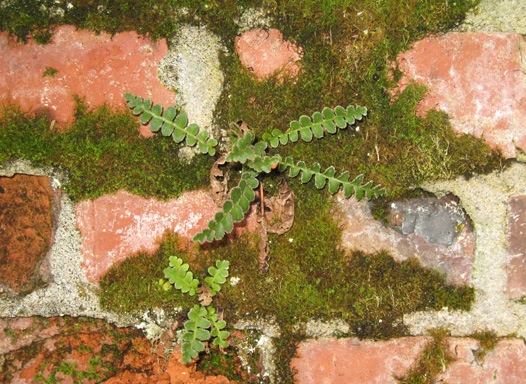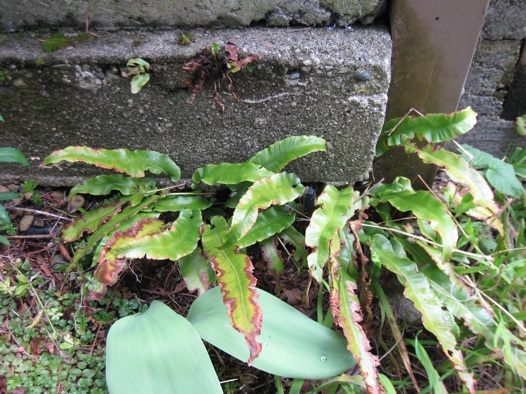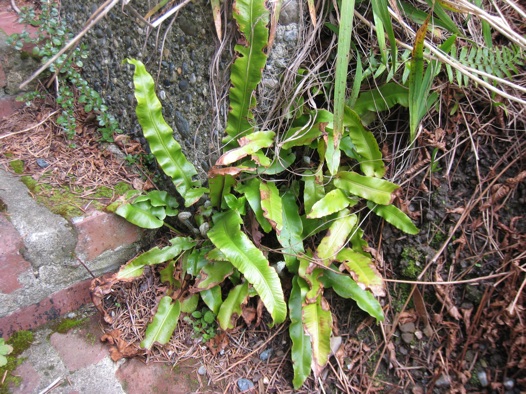| Seattle has 15 native fern species. Gardeners here cultivate dozens of beautiful non-native fern species. So far I have only found two species of non-natives reproducing outside in the Seattle area --at least in irrigated garden settings. This article features these two species of Asplenium. (In July 2010, Peter Zika discovered wild specimens of Royal Fern, Osmunda regalis in Lake Washington's Union Bay. In July 2020, I found Cyrtomium coming up wild in a Seattle garden.) |
Elsewhere on Earth there are plentiful reports of weedy ferns, naturalized ferns, garden-escaped ferns. Most ferns thrive in moist, warm-temperate regions. They reproduce by dust-like spores rather than seeds.
|
| Asplenium Ceterach L. 1753 |
| = Scolopendrium Ceterach J.E. Smith 1793 |
| = Ceterach officinarum Willd. 1804 |
= Ceterach vulgare Druce 1914
|
| Usually called Rustyback in English, it is also known as Scale or Scaly fern; Stone fern; Common spleenwort; Arabian Ceterach; Finger fern; Miltwaste. |
| The name Asplenium derives from the Greek splen (spleen) --in allusion to its being thought by the herbalist Dioscorides to be good for treating spleen diseases. Hence the English name Spleenwort. The name Ceterach comes from an Arabic word applied to the plant by Persian physicians. |
| There are about 700 species of Asplenium. |
| Below is an account from Phebe Lankester's 1860 book A plain and easy account of the British Ferns: |
| "The common name Spleenwort takes its origin in
a curious story, that in Cerito there is a river which
divides two portions of land, the Ceterach growing
abundantly on one side of the stream and not on the
other. On the side where this fern grows, the pigs
are said to have no spleen, but on the other side no
such deficiency is recorded. Hence the name Spleen-wort, or Asplenon [no spleen]. To this day, Arabian and other eastern writers believe in the virtues of this fern in
diseases of the spleen and liver." |
| Asplenium Ceterach is native to Europe and north Africa, east to the Himalayas. It is a small clumping fern of thick evergreen fronds notably dark green on top and conspicuously encrusted beneath with rusty-colored scales. The contrast is winsome. The fronds are up to about 10 inches long. Rustyback grows on walls, rocks, and usually alkaline soils. As John Gerard wrote in 1597: "Ceterach groweth upon old stone walls and rocks in darke and shadowie places." |
| I end with more from Lankester's book: |
| "The short tough roots of this fern insinuate themselves into the crevices of old walls and ruins, in rocky
places, and especially in limestone districts in England
and Ireland." |
| "On the old walls of -churches and ruins this pretty
fern seems to be quite at home. It is to be seen on the
walls of Jerusalem. Its medicinal properties were at
one time thought to be of great value, but it has fallen
into disuse with the progress of knowledge, and the
discovery that all these supposed peculiarities, existing
in various herbs and plants, depend on some astringent
or other principle which is better supplied to the
system in a more concentrated form from some other
source." |
| In January 2008 I noticed it wild in a brick wall at Jocelyn Horder's garden in Poulsbo, Washington (see my photo). |

Asplenium Ceterach / Rustyback photo by ALJ
|
| Asplenium Scolopendrium L. 1753 |
| = Phyllitis Scolopendrium (L.) Newmn. 1844 |
| = Scolopendrium vulgare J.E. Smith 1793 |
| = Scolopendrium Phyllitis Roth 1799 |
| = Scolopendrium officinarum Swartz 1802 |
= Scolopendrium officinale DC. 1805
|
| A well known, distinctive species, usually called Hart's-tongue. Other names are Hart's-tongue fern; Buttonhole; God's-hair; Hind's-tongue; Horse-tongue; Deer-tongue; Scollies. |
| From the Greek scolopendra (centipede or millipede), alluding to the rows of spores which resemble the feet of a centipede. Phyllitis is from the Greek word for leaf (phyllon). |
| It is native to Europe, NW Africa, east to Iran, Korea, Japan, and Sakhalin, with scattered populations in eastern North America and Mexico. |
| It is evergreen and its fronds are not especially ferny (feathery) to casual observers. They can measure as large as 18 inches long by 3 inches wide, and are strap-shaped --long and slender. However, it has more than 100 cultivars, and some feature markedly crisped or dissected fronds. |
| It grows on rocks, walls, hedges and banks, on calcium-rich rocks in sinkholes, at cave entrances, and on cool, moist talus --at its best in shade. |
| Herbalists and country folk have used Hart's-tongue to treat colds, erysipelas and burns. But it is not generally regarded by modern health practitioners as potent. |
| I have observed Hart's-tongue reproducing in at least 5 Seattle gardens (see my photos). |
| Lee Ellis reports that some English cultivars of Lady Fern (Athyrium Filix-femina) are reproducing in her garden. |
| In Oregon, other cultivated ferns going wild include an Australian tree fern and the east Asian Cyrtomium Fortunei J. Sm. |
In greenhouses (including in Seattle) there are plentiful weedy ferns. My question to readers in the Seattle vicinity is: what other non-native ferns do you know of coming up wild outside --either in or out of gardens? A University of Washington plant biology student is studying this matter. If you have information to share please contact Tracy Elliot rosechimera@gmail.com.
Back |

Asplenium Scolopendrium / Hart's-tongue photo by ALJ |

Asplenium Scolopendrium / Hart's-tongue photo by ALJ |

